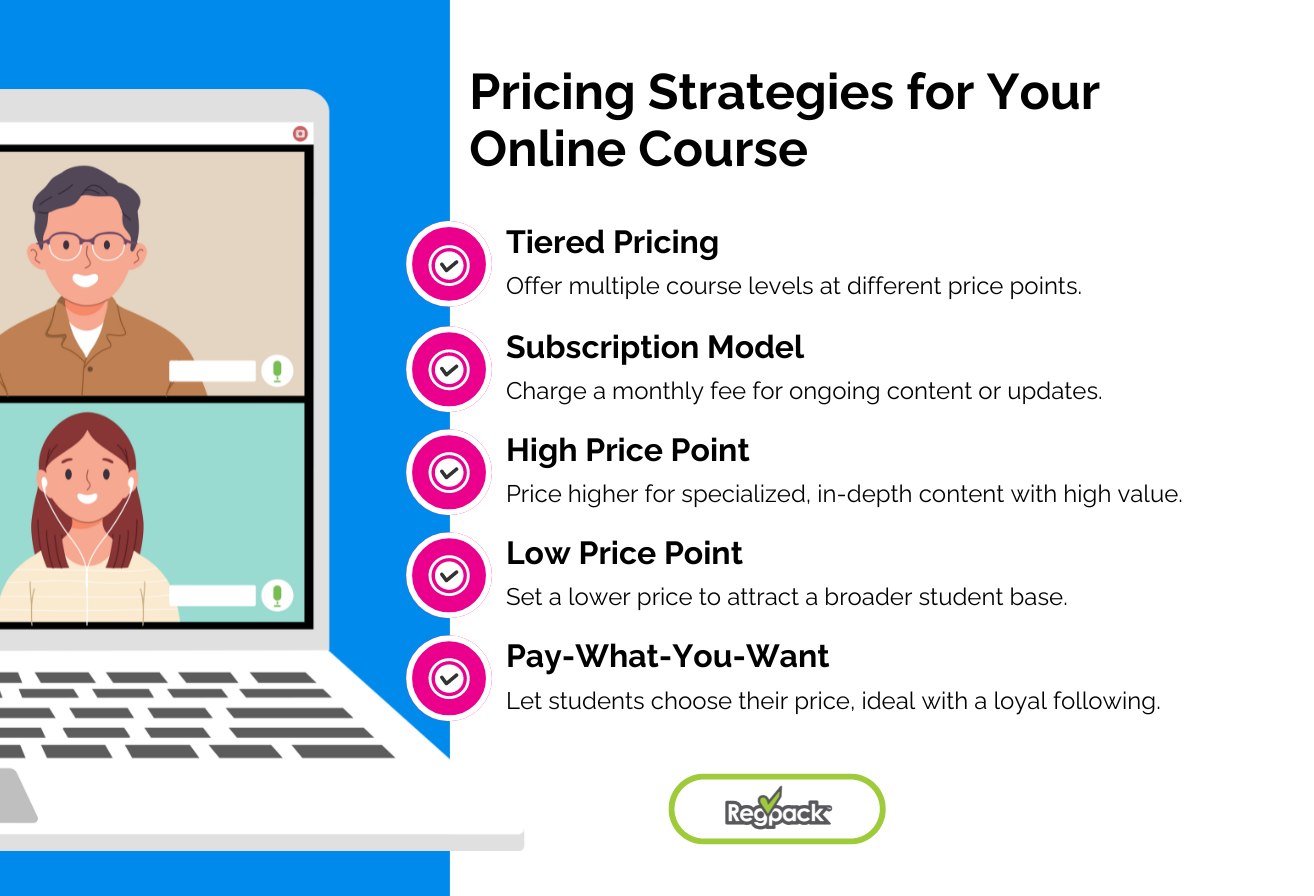Let’s set the scene: you’ve spent countless hours developing an online course that’s both engaging and comprehensive—one that’s sure to enlighten anyone who takes it. But now comes the tricky part: “How much should I charge?”
Price it too low, and you might undervalue all that hard work. Price it too high, and you risk scaring off potential customers.
Finding the right price can make all the difference in converting prospective students into paying customers, but finding that sweet spot isn’t always straightforward.
This guide will walk you through the various factors to consider when pricing your online course, ensuring you land on a price point that reflects the value of your course and resonates with your target audience.
#1 Understanding Your Target Market
The first step in pricing your online course is understanding your target market.
Ask yourself:
- Who are your potential students?
- What is their willingness to pay?
- Are they looking for premium content, or are they more price-sensitive?
Conducting thorough market research will help you gauge the market demand and perceived value of your course. Join Facebook groups, engage with your audience on social media, and build a mailing list to gather insights.
By understanding your target audience, you can tailor your pricing strategy to match their expectations.
#2 Establishing the Perceived Value of Your Course
Perceived value is key when determining your course price.
Potential buyers often associate higher price points with higher quality. This doesn’t mean you should slap a premium price tag on your course without justification.
Instead, ensure your course content, structure, and marketing strategy reflect the value you’re offering. Highlight the benefits and outcomes your course promises.
For instance, if your course offers additional benefits like one-on-one coaching or exclusive access to a community, these perks can justify a higher price.
#3 Understanding Your Costs and Potential Profit Margin
When pricing your online course, it’s important to understand your costs and potential profit margin—this is known as cost-based pricing. Start by accounting for all expenses associated with creating your course. This includes the time spent developing course material, software or equipment purchases, and the cost of hosting the course on an online platform.
But don’t stop there; consider implicit costs like the opportunity cost of your time and the potential income from other projects you might have pursued instead.
Every course creator needs to realize that while profit is a fundamental aspect of any business, in education, the balance between making a profit and providing a meaningful educational experience is the real sweet spot one should be aiming for.
Pricing strategies can have a significant impact on your course attendance and profitability.
Different Pricing Strategies for Your Online Course
There are different ways to approach online course pricing, depending on your goals and the nature of your course.

Here are a few strategies to consider:
- Tiered Pricing: Offering different levels of access or content at varying price points can cater to a broader audience. For example, you might have a basic version of your course at a lower price and a premium version with additional benefits at a higher price point.
- Subscription Model: If your course offers ongoing content or requires regular updates, consider a monthly subscription model. This approach can generate consistent revenue and lower the initial barrier to entry for potential students.
- High Price Point: If your course covers an in-depth, specialized topic with high perceived value, you might opt for a high price point. Ensure that the course content and marketing efforts reflect the premium nature of the offering.
- Low Price Point: Alternatively, if you’re aiming for mass appeal or your course is relatively short, a lower price might be more appropriate. This strategy works well for building a large student base quickly.
- Pay-What-You-Want: This flexible approach allows students to choose how much they want to pay. While this can attract a wider audience, it also requires a strong, loyal following to succeed.
#4 Determining the Right Price: The Sweet Spot
Finding the sweet spot for your course price requires balancing several factors.
Start with a baseline—what do competitors charge for similar courses? Use this as a starting point, then adjust based on your market research, content quality, and perceived value.
Test different price points to see how they impact your conversion rate. Sometimes, a slightly higher or lower price can make a big difference in sales.
#5 Researching Your Competitors and Understanding the Market
Once you understand your costs, it’s time to look at how competitors are pricing similar online courses. This isn’t just about matching or undercutting their prices; it’s about understanding the market and the perceived value of your course.
Start by making a list of competitors who offer similar content. Check out how they package their courses, what’s included, and, most importantly, their pricing. Pay attention to the differences between higher and lower-priced courses—what justifies the higher price, and is the lower-priced course undervaluing itself?
By researching your competitors, you’ll gain a clearer picture of the market, helping you set a competitive price that reflects the value of your course while resonating with your target audience.
#6 Marketing Your Course at the Right Price
Once you’ve determined the right price for your online course, it’s essential to align your marketing strategy with that price point.
Clearly communicate the value and benefits of your course across all marketing channels.
Use social media, email marketing, and content marketing to reach your potential customers.
Highlight testimonials, success stories, and the unique aspects of your course that justify its price.
Remember, your marketing efforts should reinforce the perceived value of your course.
#7 Regularly Review and Adjust
Course pricing plays a crucial role in your conversion rate—the percentage of potential customers who actually purchase your course.
A price that’s too high might deter prospective students, while a price that’s too low could devalue your course and make potential buyers question its quality.
Regularly review and adjust your pricing strategy based on sales data and feedback.
Sometimes, offering a limited-time discount or bundling your course with additional benefits can boost your conversion rate without permanently lowering your price.
Pricing Considerations for Course Creators
Your course price should reflect not only the value it offers to students but also the hard work you’ve put into developing it. Don’t undervalue your efforts—price your course in a way that ensures you’re compensated fairly for your work.
Best Practices for Online Course Pricing
Here are a few best practices to keep in mind when pricing your online course:
- Know Your Audience: Tailor your pricing strategy to your target market’s needs and expectations.
- Test Different Price Points: Experiment with different price points to find the most effective one.
- Highlight the Value: Make sure your potential students understand the benefits and outcomes of taking your course.
- Keep it Flexible: Be open to adjusting your pricing strategy based on market feedback and sales performance.
- Communicate Clearly: Ensure your marketing materials clearly convey the value of your course at its price point.
Setting the Right Course Price
Pricing your online course is both an art and a science. By following the guidelines outlined in this complete guide, you’ll be well on your way to setting a course price that attracts students, reflects your hard work, and ensures a fair return on your investment.
Online Course Registration with Regpack
Ready to take the next step in your course launch?
Use Regpack to automate your online course registration and payment processes, making it easy for students to sign up and get started.
With Regpack, you can focus on delivering high-quality content while we handle the logistics.
Contact Us Now to See How it Works
References:
“The Plain-English Guide to Cost-Based Pricing [+Examples]” Hubspot Blog, https://blog.hubspot.com/sales/cost-based-pricing. Accessed November 13, 2023.
“7 Pricing Strategies Small Businesses Should Know About” Regpacks.com,
https://www.regpacks.com/blog/pricing-strategies/. Accessed November 13, 2023.


















